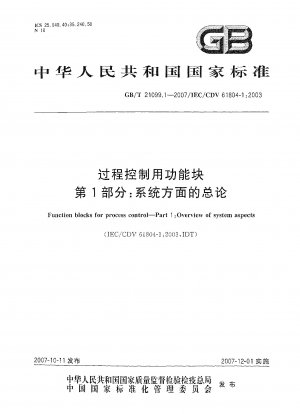GB/T 21099.1-2007
Function blocks for process control.Part 1:Overview of system aspects (English Version)
- Standard No.
- GB/T 21099.1-2007
- Language
- Chinese, Available in English version
- Release Date
- 2007
- Published By
- General Administration of Quality Supervision, Inspection and Quarantine of the People‘s Republic of China
- Latest
- GB/T 21099.1-2007
- Scope
- This part of GB/T 21099 provides a specification for suppliers in the form of general guidance to meet the evolving needs of digital process control systems. Through this specification, users can ensure the compatibility, interoperability, interconnectability, interoperability, and interchangeability of their selected equipment. Figure 2 shows the different impacts, basic specifications and technical support for GB/T 21099 from top-down and bottom-up perspectives. GB/T 21099 affects national standards and projects related to the same field. These standards are either technology-agnostic, supporting a top-down approach, or they are technology-specific, such as programmable controllers or fieldbuses. Together they form the basis of the standards specified in GB/T 21099. The main purpose of this section is to align the different perspectives, models and starting points of end users, system suppliers and equipment manufacturers. It will be a reference document that guides discussions during the development of subsequent specifications and guides readers of GB/T 21099.2. This section gives the general requirements. For better understanding, background information and examples are given in the appendix of this section. This section defines requirements for FBs to provide control, maintenance facilitation, and technical management applications that interact with measuring devices and actuators: Control includes the functions necessary to bring the process to and maintain desired characteristics; Maintenance includes Functions for collecting status information of process equipment and automation equipment and adjusting them, eg calibrating a sensor with drift; · Technical management of process optimization information. The main concern is the economics of the process and plant equipment. Of particular relevance is the measurement of the performance and reliability of an item of plant or equipment during installation and a comparison of the performance and reliability of an item from different suppliers performing the same function in the same operating environment. An example of performance is the number of cycles achieved before failure for two valves from different suppliers. This allows detailed, efficient statistical analyzes to be generated to support decision-making management and changes to plant equipment. A prerequisite for designing, implementing and running a FB-based process control system is that tools, equipment and other components follow the same architecture based on common specifications. This architecture is used to define the components of the system, such as functional blocks, devices, data, data connections, and the relationships between these components. The general function block model of GB/T 19769 related to this part can provide these basic components of function blocks for process control. What GB/T 19769 needs to supplement is the specification of the FB parameters and functions implemented in the device. The architecture and scope of the function blocks that must be specified are described in 7.4. 7.4 contains the minimum set of function blocks required by the process industry. They appear in two different chapters, one dealing with "advanced" function blocks, which contain complex but common functionality required by most process industries like control loops (e.g., proportional, integral, derivative - PID), and the other containing EFB (Elementary FB) sets, such as the required Boolean functions, can be composed of specific and unique functionality. FB is applied to the entire life cycle of the process control system and can be observed from different aspects. This is detailed in Appendix A. Process design begins with a Piping and Instrumentation Diagram (P&ID), which presents process control and instrumentation requirements from a purely functional perspective. With P&ID, the desired characteristics of a process control system are abstracted as a Functional Requirements Diagram (FRD), without considering the detailed behavior of the basic equipment.
GB/T 21099.1-2007 Referenced Document
- GB/T 2900.56-2002 Electrotechnical terminology--Automatic control
- GB/T 5271.1-2000 Information technology-Vocabulary Part1:Fundamental terms
- GB/T 5271.11-2000 Information technology-Vocabulary-Part 11:Processing units
- GB/T 5271.12-2000 Information technology-Vocabulary-Part 12:Peripheral equipment
- GB/T 5271.20-1994 Information technology--Vocabulary--Part 20:System development
- GB/T 5271.23-2000 Information technology-Vocabulary-Part 23:Text processing
- GB/T 5271.24-2000 Information technology-Vocabulary-Part 24:Computer-integrated manufacturing
- GB/T 5271.25-2000 Information technology-Vocabulary Part 25:Local area networks
- GB/T 5271.27-2001 Information technology--Vocabulary Part 27: Office automation
- GB/T 5271.28-2001 Information technology--Vocabulary Part 28: Artificial intelligence--Basic concepts and expert system
- GB/T 5271.4-2000 Information technology-Vocabulary Part 4:Organization of data
- GB/T 5271.6-2000 Information technology-Vocabulary-Part 6:Preparation and handling of data
- GB/T 5271.8-2001 Information technology-Vocabulary Part 8: Security
- GB/T 5271.9-2001 Information technology--Vocabulary Part 9: Data communication
GB/T 21099.1-2007 history
- 2007 GB/T 21099.1-2007 Function blocks for process control.Part 1:Overview of system aspects

GB/T 21099.1-2007 -All Parts
GB/T 21099.1-2007 Function blocks for process control.Part 1:Overview of system aspects
GB/T 21099.2-2015 Function blocks (FB) for process control - Part 2: Function block concept specification
GB/T 21099.3-2018 Function block (FB) for process control.Part 3:Electronic device description language (EDDL)
GB/T 21099.4-2010 Function blocks(FB) for process control.Part 4: EDD interoperability guideline